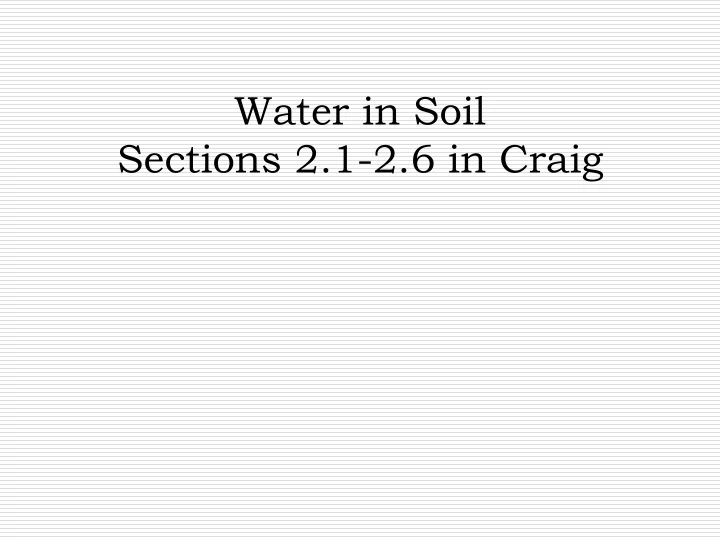

Water in Soil Sections 2.1-2.6 in Craig
Outlines Introduction Darcy’s Law Volume of water flowing per unit time Measuring K in laboratory Seepage Theory Flow Net
Introduction All soils are permeable materials, water being free to flow through the interconnected pores between the solid particles. You must know how much water is flowing through a soil per unit time. This knowledge is required to Design earth dams. Determine the quantity of seepage under hydraulic structures. and dewater foundations before and during their construction. The pressure of the pore water is measured relative to atmospheric pressure and the level at which the pressure is atmospheric (i.e. zero) is defined as the water table (WT) or the phreatic surface. Below the water table the soil is assumed to be fully saturated, Below the water table the pore water may be static, the hydrostatic pressure depending on the depth below the water table, or may be seeping through the soil under hydraulic gradient: this chapter is concerned with the second case.
Introduction Bernoulli’s theorem applies to the pore water but seepage velocities in soils are normally so small that velocity head can be neglected where h is the total head, u the pore water pressure, w the unit weight of water (9.8 kN/m 3 ) and z the elevation head above a chosen datum.
Darcy’s law Darcy (1856) proposed the following equation for calculating the velocity of flow of water through a soil: In this equation, v = Darcy velocity (unit: cm/sec) k = hydraulic conductivity of soil (unit: cm/sec) i = hydraulic gradient The hydraulic gradient is defined as where h = piezometric head difference between the sections at AA and B B L = distance between the sections at AA and BB (Note: Sections AA and BB are perpendicular to the direction of flow.)
Volume of water flowing per unit time where q is the volume of water flowing per unit time, A the cross- sectional area of soil corresponding to the flow, The K also varies with temperature, upon which the viscosity of the water depends. If the value of k measured at 20 C is taken as 100% then the values at 10 and 0 C are 77 and 56%, respectively. The coefficient of permeability can also be represented by the equation: where w is the unit weight of water, the viscosity of water and K (units m2) an absolute coefficient depending only on the characteristics of the soil skeleton.
The values of k for different types of soil are typically within the ranges shown in Table
seepage velocity On the microscopic scale the water seeping through a soil follows a very tortuous path between the solid particles but macroscopically the flow path The seepage velocity Av: the average area of voids The porosity, n, can also be expressed as
Measuring K in laboratory Two Main Method The coefficient of permeability for coarse soils can be determined by means of the constant-head permeability test For fine soils (clays and silt) the falling-head test should be used Laboratory permeability tests: (a) constant head and (b) falling head.
Measuring K in laboratory (a) constant head and (b) falling head. For Clean Uniform sands, Hazen showed that the approximate value of k is given by where D 10 is the effective size in mm.
Seepage Theory The general case of seepage in two dimensions will now be considered Assumption soil is homogeneous and isotropic Generalized Darcy Law will be used
Derivation total head h decreasing in the directions of v x and v z (1) q in =q out (2) = (3) equation of continuity in two dimensions.
Solution Two Functions satisfy Laplace Equation First function (x, z), called the potential function, Second function (x, z), called the flow function, In Eq 3 If the function (x, z) is given a constant value 1 then d =0 and If (x, z) is constant then d = 0 and
Flow Net
Constrained for Flow Net
Flow Net under Dam
Flow Net in Backfill of Retaining Wall
INTERPRETATION OF FLOW NET Head loss between each consecutive pair of equipotential lines H h N d Flow through each flow channel for an isotropic soil from Darcy’s Law h b H b q Aki b 1 k k h k L L N L d Total flow N H N f f q k ( ) k H i N N i 1 d d
Hydraulic Gradient Hydraulic gradient over each square h i L Maximum hydraulic gradient h i max L min Critical Hydraulic Gradient Critical hydraulic gradient that brings a soil mass to static liquefaction, , Heaving, Boiling, and Piping G 1 G 1 s w s i i ( ) cr 1 e 1 e w w Safe if i<i critical F.S=i critical /i exit 1.0
Pore Water Pressure Distribution Pressure head h H ( N ) h h p d j z j Pore water pressure u h j p w j Uplift Forces n P u x w j j j 1 Calculating the uplift force per unit length using Simpson’s rule n n x P u u 2 u 4 u w 1 n i i 3 i 3 i 2 odd even
ANISOTROPIC SOIL CONDITIONS Most natural soil deposits are anisotropic, with the coefficient of permeability having a maximum value in the direction of stratification and a minimum value in the direction normal to that of stratification; these directions are denoted by x and z, respectively, i.e. Same solution but you need to have x t instead of x and K’ instead of K in flow equation.
Non-homogeneous Soil Conditions For horizontal flow, the head drop Dh over the same flow path length H1+H2 will be the same for each layer. For vertical flow, the flow rate q through area A of each layer is the same.
Recommend
More recommend